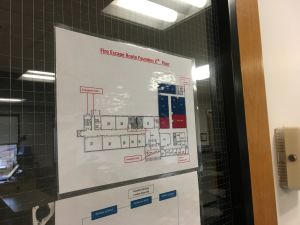According to the New York Times, teachers across the country will soon be able to participate and train in a school shooting simulation this spring. The computer simulation was created by the federal government and has realistic details of the gunfire, shattering of glass and the screams of children.

The simulation was shaped after a real school that includes multiple classrooms, a library, cafeteria and a gymnasium. The Department of Homeland Security has funded the program, which costs 5.6 million.
Dr. Joseph Cimakasky, assistant professor of philosophy at Cabrini, believes that it is a good idea to have the simulation because it is the first step in getting an idea of what should be done in that situation.
He says the simulation would give teachers a sense of direction of what they should do.
When asked if the simulation should be required for all levels of school when it is released, Cimakasky said, “Unfortunately, yes. We do it with fire drills.”
As fire drills were standard safety drills school districts did, lock down drills are now a part of the procedure. Some schools are considering adding the simulation to train their staff members.

In a demonstration video by Homeland Security, Milt Nenneman, project manager for the U.S. Department of Homeland Security Science and Technology directorate, explained the simulation and the different ways faculty can use it. He also explained that the simulation is a part of a virtual training program, EDGE.
EDGE stands for Enhanced Dynamic Geo-Social Environment. It was developed in the science and technology division of the Department of Homeland Security and the Army Research Laboratory.
“I think that the school shooting simulation would be a good idea for teachers to use,” Alexas Flax, a sophomore at Cabrini, said. “This would give them some practice on what to do if a shooting could happen in their school district.”
Flax thinks that teachers should not only use the simulation but also have to do real life practice just to understand how to handle these types of situations.
“Playing a game is different than actually experiencing it,” Flax said.
Any staff that participates in the simulation can choose to be a student, teacher, other school employees, law enforcement and even the shooter. People can decide how to act, instead of leaving it to the software to choose.

“The drill is very important for Cabrini to participate in because the campus has several entrances and exits that are accessible to the public,” Christopher Jones, Holy Spirit Library circulation and building manager, said. “Anyone can visit the campus without showing I.D. during the day and that exposes the college to potential threats, including someone unstable who may posses a firearm.”
Jones also believes that elementary and middle schools should require their teachers and staff to be trained. Jones, too, said high school students should do the simulation themselves, as it would be helpful to them as well.
Sam Gwalthney, a sophomore at Cabrini, thinks the simulation is a good idea but another part of her thinks it is not.
“I’m not sure if it’ll be effective because it depends on how many schools choose to implement the simulation,” Gwalthney said. “If released, I don’t think that all schools should be required to do this simulation but at least have some kind of teaching put in place in case a school shooting were to happen.”


